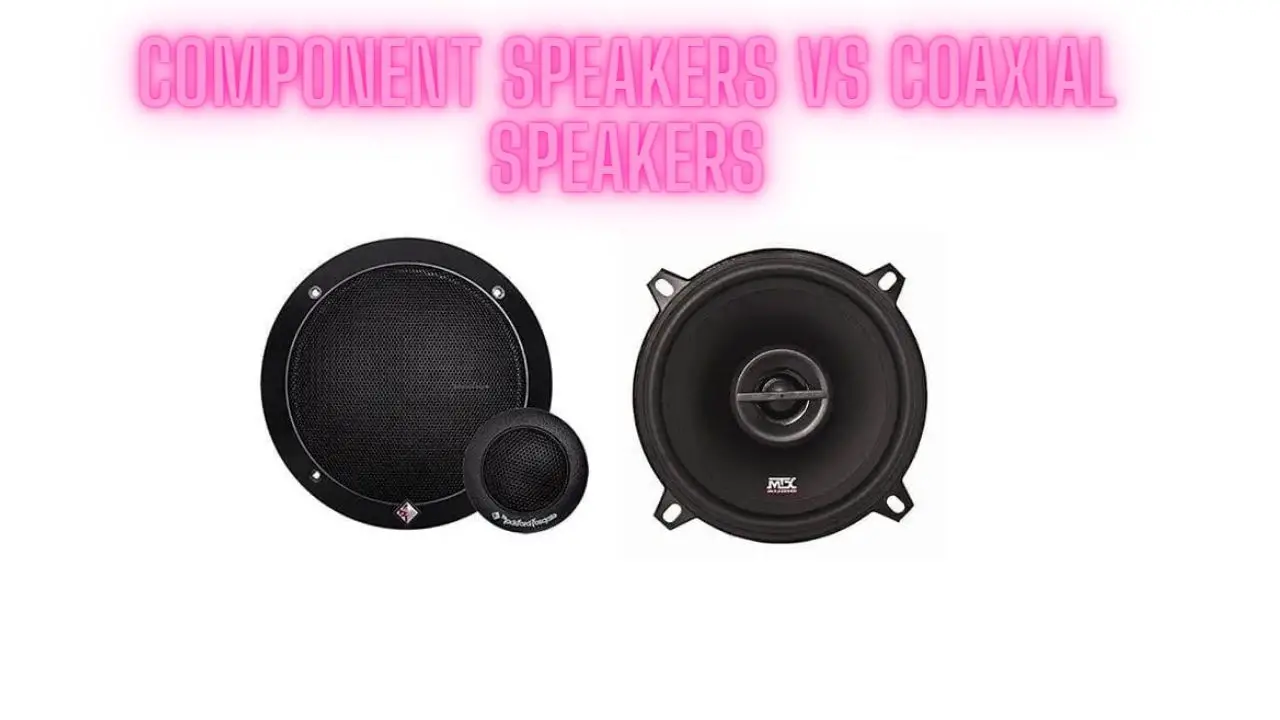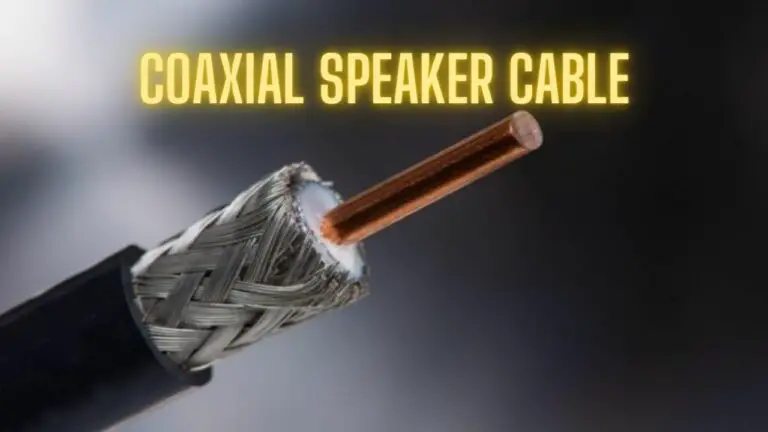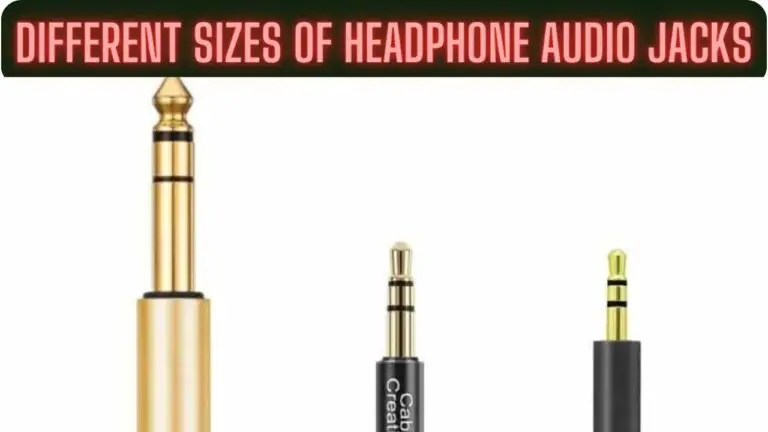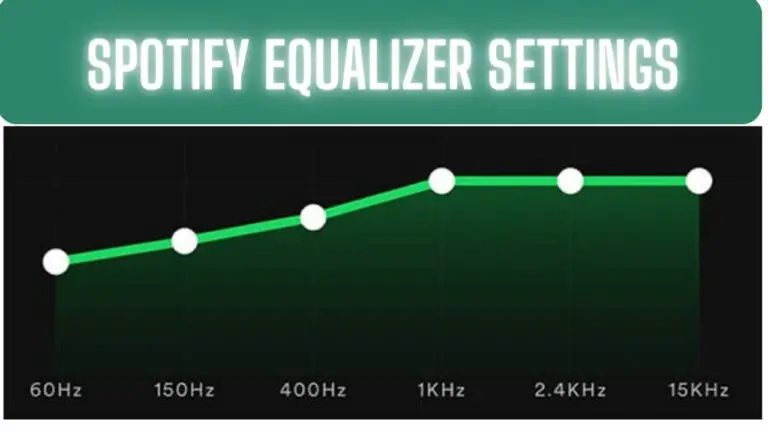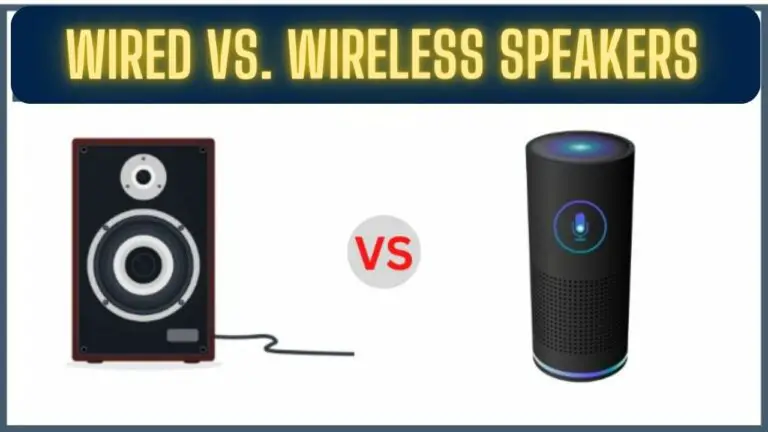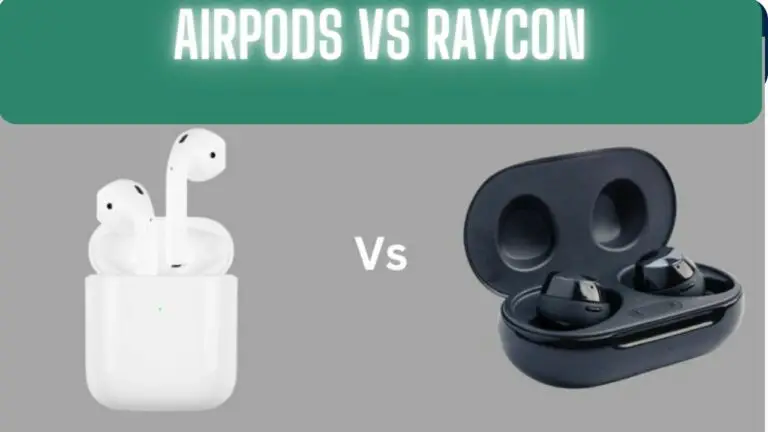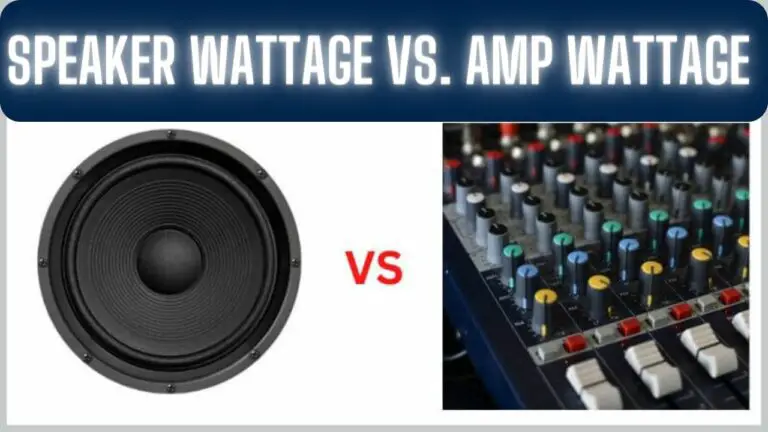Component Speakers Vs Coaxial Speakers: Key Differences
Introduction:
Speakers are integral components of audio systems, responsible for transforming electrical signals into sound waves that we can hear. When it comes to selecting speakers for your audio setup, two common options are component speakers and coaxial speakers. Both types have their distinct characteristics, advantages, and disadvantages.
In this comparison, we’ll delve into the differences between component speakers and coaxial speakers to help you make an informed decision based on your audio needs and preferences. We’ll explore various aspects including construction, sound quality, installation complexity, cost, and suitability for different applications. By the end, you’ll have a better understanding of which speaker type may be the best fit for your particular audio setup.
Component Speakers
Component speakers consist of multiple separate drivers, typically including a woofer, tweeter, and crossover network. Each driver is responsible for reproducing a specific range of frequencies, allowing for more precise sound reproduction compared to coaxial speakers.
- Composition:
- Woofer: The woofer is responsible for producing low frequencies, typically ranging from around 20 Hz to 2 kHz. It’s larger in size compared to the tweeter and is designed to move air efficiently for bass reproduction.
- Tweeter: The tweeter handles high frequencies, usually ranging from around 2 kHz to 20 kHz. It’s smaller and designed to produce clear and detailed treble sounds.
- Crossover Network: The crossover network divides the audio signal into appropriate frequency ranges for each driver. It ensures that the woofer receives low frequencies and the tweeter receives high frequencies, preventing distortion and ensuring optimal performance from each driver.
- Advantages:
- Sound Quality: Component speakers typically offer superior sound quality compared to coaxial speakers due to the dedicated drivers and crossover network. They provide clearer highs, more defined mids, and tighter bass.
- Customization Options: Component systems allow for customization of individual drivers, enabling users to tailor the sound to their preferences and optimize the audio performance.
- Imaging and Staging: With separate drivers positioned strategically in the vehicle or room, component speakers can create a more immersive listening experience with precise imaging and staging.
- Disadvantages:
- Cost: Component speaker systems tend to be more expensive than coaxial speakers due to the multiple drivers and crossover network.
- Installation Complexity: Installing component speakers may require more time and expertise, especially for mounting separate drivers and configuring the crossover network correctly.
Overall, component speakers are favored by audio enthusiasts and professionals seeking the highest level of sound quality and customization options in their audio systems. However, they may require a higher budget and more involved installation process compared to coaxial speakers.
Coaxial Speakers
Coaxial speakers, also known as full-range speakers, integrate multiple drivers into a single unit. These drivers typically include a woofer and a tweeter, sometimes accompanied by additional components like midrange drivers. Unlike component speakers, coaxial speakers do not utilize a separate crossover network for dividing frequencies.
- Composition:
- Woofer: The woofer in a coaxial speaker is responsible for reproducing low to mid-range frequencies, typically covering the range from around 20 Hz to 5 kHz. It’s larger in size compared to the tweeter and is designed to handle bass and midrange frequencies.
- Tweeter: The tweeter handles high frequencies, usually ranging from around 5 kHz to 20 kHz. It’s smaller and positioned at the center of the woofer cone or mounted on a pole piece to produce clear treble sounds.
- Midrange Driver (Optional): Some coaxial speakers may include an additional midrange driver to improve midrange frequency reproduction, especially in larger speaker sizes.
- Advantages:
- Ease of Installation: Coaxial speakers are easier to install compared to component speakers due to their single-unit design. They require less space and typically have simpler wiring requirements, making them a popular choice for straightforward installations.
- Cost-Effectiveness: Coaxial speakers are often more affordable than component speakers, making them a budget-friendly option for those seeking decent sound quality without breaking the bank.
- Compact Design: The integration of multiple drivers into a single unit results in a more compact speaker design, making coaxial speakers suitable for installations where space is limited.
- Disadvantages:
- Sound Quality Limitations: While coaxial speakers offer convenience and affordability, they may not deliver the same level of sound quality and clarity as component speakers. The integration of drivers within a single unit can result in compromises in sound reproduction, especially in terms of imaging and separation of frequencies.
- Limited Customization: Unlike component speakers, coaxial speakers do not offer as much customization in terms of adjusting individual driver performance or optimizing crossover settings.
In summary, coaxial speakers provide a convenient and cost-effective solution for audio systems where simplicity and space constraints are priorities. While they may not offer the same level of sound quality and customization options as component speakers, they remain a popular choice for many consumers seeking a balance between performance and affordability.
Sound Quality Comparison
When comparing the sound quality of component speakers and coaxial speakers, several factors come into play, including frequency response, clarity, detail, imaging, and staging.
- Frequency Response:
- Component Speakers: Component speakers typically offer a more accurate and extended frequency response compared to coaxial speakers. With dedicated drivers for different frequency ranges and a well-designed crossover network, component speakers can reproduce a wider range of frequencies with greater precision.
- Coaxial Speakers: While coaxial speakers can provide a decent frequency response, they may not be able to reproduce extreme frequencies as accurately as component speakers. The integration of multiple drivers into a single unit may lead to some compromise in frequency reproduction, especially in the midrange and high frequencies.
- Clarity and Detail:
- Component Speakers: Due to their separate drivers and optimized crossover networks, component speakers often deliver clearer and more detailed sound across the entire frequency spectrum. This results in better separation of instruments and vocals, allowing for a more immersive listening experience with finer nuances in the audio.
- Coaxial Speakers: Coaxial speakers can provide satisfactory clarity and detail, especially in the midrange frequencies where the woofer and tweeter work together seamlessly. However, they may not offer the same level of detail and resolution as component speakers, particularly in the high frequencies where the tweeter’s performance may be limited.
- Imaging and Staging:
- Component Speakers: With their ability to precisely control the placement and performance of individual drivers, component speakers excel in creating a well-defined soundstage with accurate imaging. This means that listeners can perceive the location and direction of instruments and vocals more accurately, resulting in a more immersive and lifelike listening experience.
- Coaxial Speakers: Coaxial speakers can provide a decent soundstage and imaging, thanks to the coaxially mounted tweeter positioned at the center of the woofer cone. However, the single-unit design may limit the speaker’s ability to create a truly expansive and accurate soundstage compared to component speakers.
In summary, while both component speakers and coaxial speakers can deliver satisfactory sound quality, component speakers generally have the edge when it comes to accuracy, detail, imaging, and staging. However, the difference in sound quality may vary depending on the specific models and implementations of each speaker type, as well as factors such as installation, room acoustics, and personal preferences.
Installation Considerations
When choosing between component speakers and coaxial speakers, it’s essential to consider the installation requirements and challenges associated with each speaker type. Here are some key factors to consider:
- Space Requirements:
- Component Speakers: Installing component speakers typically requires more space compared to coaxial speakers. This is because component systems consist of separate drivers (woofer, tweeter) that need to be mounted individually, as well as a crossover network that may need to be housed separately. As a result, component speakers may require additional space in the vehicle or room for mounting and positioning each driver.
- Coaxial Speakers: Coaxial speakers feature a single-unit design, which makes them more compact and space-efficient compared to component speakers. They can be installed in locations with limited space, such as factory speaker locations in vehicles or smaller rooms, without the need for additional mounting hardware or extensive modifications.
- Wiring Complexity:
- Component Speakers: Wiring component speakers can be more complex compared to coaxial speakers, especially when dealing with multiple drivers and a crossover network. Each driver typically requires its own set of wires, and the crossover network needs to be connected properly to ensure optimal performance. This may require additional wiring and careful routing to avoid interference or signal degradation.
- Coaxial Speakers: Coaxial speakers have a simpler wiring setup since they consist of a single unit with integrated drivers. This reduces the number of wires needed for installation, making it easier to connect the speakers to the audio system without the complexity of dealing with separate drivers and crossovers.
- Speaker Placement:
- Component Speakers: Component speakers offer more flexibility in speaker placement, allowing for optimal positioning to achieve the desired soundstage and imaging. The separate drivers can be mounted in locations that optimize sound dispersion and minimize reflections, enhancing the overall listening experience. However, finding suitable locations for mounting each driver may require careful planning and customization.
- Coaxial Speakers: Coaxial speakers are designed for easy installation in factory speaker locations or standard mounting locations without the need for extensive modifications. The single-unit design simplifies the installation process and ensures a consistent sound dispersion pattern, although the positioning options may be somewhat limited compared to component speakers.
In summary, the choice between component speakers and coaxial speakers involves considering factors such as space requirements, wiring complexity, and speaker placement preferences. While component speakers offer greater customization and potential for optimized sound quality, coaxial speakers provide a more straightforward installation process and may be more suitable for applications with space constraints or where simplicity is prioritized.
Cost Analysis
When comparing component speakers and coaxial speakers, it’s important to consider the cost implications beyond just the initial purchase price. Here’s a breakdown of the cost factors associated with each speaker type:
- Initial Purchase Cost:
- Component Speakers: Component speaker systems typically have a higher initial purchase cost compared to coaxial speakers. This is because component systems consist of multiple separate drivers (woofer, tweeter) and may include a crossover network, all of which contribute to the overall cost. High-quality component speakers with premium materials and advanced features can be quite expensive.
- Coaxial Speakers: Coaxial speakers are generally more affordable in terms of initial purchase cost compared to component speakers. The single-unit design and simpler construction contribute to lower production costs, making coaxial speakers a budget-friendly option for those with limited budgets or looking for a cost-effective upgrade.
- Long-Term Value:
- Component Speakers: While component speakers may have a higher upfront cost, they often provide better long-term value in terms of sound quality and performance. Investing in high-quality component speakers can result in a more satisfying listening experience with greater clarity, detail, and imaging compared to cheaper coaxial speakers. Additionally, component speakers may offer more opportunities for future upgrades and customization, allowing users to fine-tune their audio system over time.
- Coaxial Speakers: Coaxial speakers may offer good value for those seeking a simple and affordable audio upgrade. However, lower-priced coaxial speakers may lack the sound quality and durability of higher-end models, potentially leading to the need for replacement or upgrade sooner than expected. It’s important to consider the quality and reputation of the brand when purchasing coaxial speakers to ensure long-term satisfaction.
- Cost-to-Performance Ratio:
- Component Speakers: Component speakers generally offer a higher cost-to-performance ratio compared to coaxial speakers, especially in terms of sound quality and customization options. While they may have a higher upfront cost, the improved performance and flexibility of component systems justify the investment for many audio enthusiasts and professionals.
- Coaxial Speakers: Coaxial speakers provide a more budget-friendly option for those seeking a basic audio upgrade without the complexity or expense of component systems. While they may not offer the same level of performance or customization as component speakers, coaxial speakers can still provide satisfactory sound quality and value for everyday listening needs.
In summary, the cost analysis of component speakers versus coaxial speakers involves considering factors such as initial purchase cost, long-term value, and cost-to-performance ratio. While component speakers may require a higher upfront investment, they often provide superior sound quality and customization options, making them a worthwhile investment for those seeking the best audio experience. However, coaxial speakers offer a more affordable option for those on a budget or looking for a simpler audio upgrade without sacrificing too much in terms of quality.
Application Specifics
When deciding between component speakers and coaxial speakers, it’s essential to consider the specific application or use case for the speakers. Different environments and audio systems may have unique requirements and preferences. Here’s how component speakers and coaxial speakers compare in various applications:
- Car Audio Systems:
- Component Speakers: Component speakers are popular choices for car audio enthusiasts looking to achieve high-quality sound reproduction and customization in their vehicles. With separate drivers and a crossover network, component systems can provide excellent imaging and staging, making them ideal for creating a dynamic listening experience in a car environment. However, installation may require more expertise and customization to fit the specific layout of the vehicle.
- Coaxial Speakers: Coaxial speakers are commonly used as factory replacements or aftermarket upgrades in car audio systems due to their ease of installation and affordability. They offer a simple plug-and-play solution for improving sound quality without the need for extensive modifications. While they may not offer the same level of sound quality or customization as component speakers, coaxial speakers can still provide satisfactory performance for everyday listening in a car.
- Home Audio Setups:
- Component Speakers: Component speakers are favored for home audio setups where sound quality and customization are paramount. They allow users to create a tailored listening experience with precise control over speaker placement and performance. Component systems excel in delivering accurate sound reproduction with clear imaging and staging, making them ideal for home theaters, stereo systems, and dedicated listening rooms.
- Coaxial Speakers: Coaxial speakers are often used in home audio setups where simplicity and space-saving are priorities. They offer a compact and integrated solution for delivering decent sound quality in living rooms, bedrooms, or smaller spaces. While they may not offer the same level of performance or customization as component speakers, coaxial speakers can provide a convenient and cost-effective option for casual listening in a home environment.
- Professional Audio Environments:
- Component Speakers: In professional audio environments such as recording studios, sound reinforcement systems, or live performance venues, component speakers are preferred for their precision and flexibility. They allow audio engineers to fine-tune the sound to meet specific requirements and achieve optimal results in terms of clarity, detail, and accuracy.
- Coaxial Speakers: Coaxial speakers may be used in professional audio applications where simplicity and reliability are prioritized over absolute performance. While they may not offer the same level of sound quality or customization as component speakers, coaxial speakers can still provide a practical solution for background music, paging systems, or secondary monitoring applications.
In summary, the choice between component speakers and coaxial speakers depends on the specific application and requirements of the audio system. While component speakers excel in delivering superior sound quality and customization options, coaxial speakers offer a more straightforward and cost-effective solution for everyday listening needs in various environments.
Component Speakers Vs Coaxial Speakers FAQs
- What are component speakers?
- Component speakers consist of separate drivers, including a woofer, tweeter, and crossover network. Each driver is responsible for reproducing a specific range of frequencies, allowing for more precise sound reproduction compared to coaxial speakers.
- What are coaxial speakers?
- Coaxial speakers, also known as full-range speakers, integrate multiple drivers into a single unit. These drivers typically include a woofer and a tweeter, sometimes accompanied by additional components like midrange drivers. Coaxial speakers do not utilize a separate crossover network.
- Which speaker type offers better sound quality?
- Component speakers generally offer superior sound quality compared to coaxial speakers due to their dedicated drivers and optimized crossover networks. Component systems provide clearer highs, more defined mids, and tighter bass, making them ideal for audiophiles and enthusiasts.
- Are coaxial speakers easier to install?
- Yes, coaxial speakers are easier to install compared to component speakers. Their single-unit design and simpler wiring requirements make them a plug-and-play solution for upgrading factory audio systems or adding speakers to existing setups without the need for extensive modifications.
- Are component speakers more expensive than coaxial speakers?
- Yes, component speakers tend to be more expensive than coaxial speakers. This is because component systems consist of multiple separate drivers and may include a crossover network, all of which contribute to the overall cost. However, component speakers often provide better long-term value and performance.
- Which speaker type is better for car audio systems?
- Both component speakers and coaxial speakers can be suitable for car audio systems, depending on your priorities and budget. Component speakers are favored for achieving high-quality sound reproduction and customization, while coaxial speakers offer a more practical and cost-effective solution for casual listening in vehicles.
- Can coaxial speakers provide satisfactory sound quality?
- Yes, coaxial speakers can provide satisfactory sound quality for everyday listening needs. While they may not offer the same level of performance or customization as component speakers, coaxial speakers can still deliver decent sound quality, making them a popular choice for budget-conscious consumers.
- Which speaker type is better for home audio setups?
- Component speakers are generally favored for home audio setups where sound quality and customization are paramount. They allow users to create a tailored listening experience with precise control over speaker placement and performance. However, coaxial speakers can provide a more straightforward and cost-effective option for casual listening in smaller rooms or spaces with limited setup options.
These FAQs address common questions about component speakers and coaxial speakers, helping consumers make informed decisions based on their specific audio needs and preferences.
Conclusion
In conclusion, the choice between component speakers and coaxial speakers ultimately depends on your specific audio needs, preferences, and budget. Here’s a summary of key points to consider:
- Sound Quality: Component speakers typically offer superior sound quality compared to coaxial speakers, thanks to their separate drivers and optimized crossover networks. They provide clearer highs, more defined mids, and tighter bass, making them ideal for audiophiles and enthusiasts seeking the best possible audio experience.
- Customization Options: Component speakers allow for greater customization and fine-tuning of the sound, enabling users to tailor the audio performance to their preferences and optimize the listening experience. This flexibility makes them ideal for those who prioritize personalized sound reproduction and are willing to invest the time and effort into installation and setup.
- Ease of Installation: Coaxial speakers are easier to install compared to component speakers due to their single-unit design and simpler wiring requirements. They offer a plug-and-play solution for upgrading factory audio systems or adding speakers to existing setups without the need for extensive modifications.
- Cost: Component speakers tend to be more expensive than coaxial speakers, primarily due to the multiple drivers and crossover networks involved. While they may require a higher upfront investment, component speakers often provide better long-term value and performance, making them a worthwhile investment for audio enthusiasts.
- Application Specifics: Consider the specific application or use case for the speakers, whether it’s for car audio systems, home audio setups, or professional environments. Component speakers are favored for applications where sound quality and customization are paramount, while coaxial speakers offer a more practical and cost-effective solution for casual listening in various environments.
In conclusion, both component speakers and coaxial speakers have their own advantages and disadvantages, and the best choice depends on your individual preferences, priorities, and budget. Whether you prioritize sound quality, ease of installation, or customization options, there’s a speaker option available to suit your needs and enhance your audio experience.

